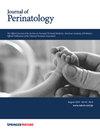近红外光谱对早产儿肾氧合监测的评价:肾脏位置、深度和侧位差异。
IF 2.4
3区 医学
Q2 OBSTETRICS & GYNECOLOGY
引用次数: 0
摘要
前言:近红外光谱(NIRS)监测早产儿肾氧合越来越多。我们试图评估肾脏定位和左右肾氧合的差异。结果:皮肤与上肾深度(0.39 cm和0.38 cm;P = 0.62)或脊柱到肾脏的距离(1.06和1.02 cm;p = 0.31)。右-左皮肤到下肾的深度分别为2.15 cm和2.04 cm;p = 0.02)。左肾氧合高于右肾(65.6 vs 62.7%, p = 10%)的新生儿为37%。结论:早产儿肾深及左右氧合存在差异。本文章由计算机程序翻译,如有差异,请以英文原文为准。

Evaluation of kidney oxygenation monitoring with near infrared spectroscopy in preterm neonates: kidney location, depth, and laterality differences
Near infrared spectroscopy (NIRS) monitoring of preterm kidney oxygenation is increasing. We sought to evaluate kidney positioning and oxygenation differences between the right and left kidneys. Preterm neonates <32 weeks’ gestational age were enrolled in a prospective observational NIRS study. Two three-hour epochs of simultaneous bilateral kidney monitoring were performed (5–8 days, 9–14 days). Point of care kidney ultrasound was performed once between days 5 and 12. There were no right-left differences in skin to superior kidney depth (0.39 and 0.38 cm; p = 0.62) or spine to kidney distance (1.06 and 1.02 cm; p = 0.31). There was a difference in right-left skin to inferior kidney depth (2.15 and 2.04 cm; p = 0.02). There was higher oxygenation in the left kidney compared to the right (65.6 vs. 62.7%, p < 0.01). Hourly individual differences of >10% were seen in 37% of neonates. Differences in kidney depth and right-left oxygenation exist in preterm neonates.
求助全文
通过发布文献求助,成功后即可免费获取论文全文。
去求助
来源期刊

Journal of Perinatology
医学-妇产科学
CiteScore
5.40
自引率
6.90%
发文量
284
审稿时长
3-8 weeks
期刊介绍:
The Journal of Perinatology provides members of the perinatal/neonatal healthcare team with original information pertinent to improving maternal/fetal and neonatal care. We publish peer-reviewed clinical research articles, state-of-the art reviews, comments, quality improvement reports, and letters to the editor. Articles published in the Journal of Perinatology embrace the full scope of the specialty, including clinical, professional, political, administrative and educational aspects. The Journal also explores legal and ethical issues, neonatal technology and product development.
The Journal’s audience includes all those that participate in perinatal/neonatal care, including, but not limited to neonatologists, perinatologists, perinatal epidemiologists, pediatricians and pediatric subspecialists, surgeons, neonatal and perinatal nurses, respiratory therapists, pharmacists, social workers, dieticians, speech and hearing experts, other allied health professionals, as well as subspecialists who participate in patient care including radiologists, laboratory medicine and pathologists.
 求助内容:
求助内容: 应助结果提醒方式:
应助结果提醒方式:


